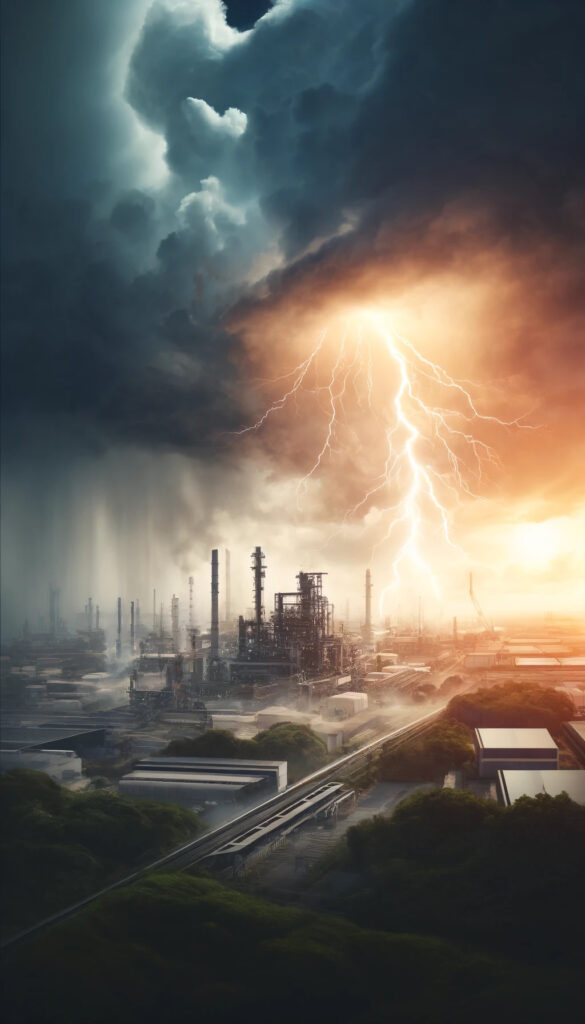Introduction
At Ekoakua, we are experts in offering advanced solutions for protecting industrial installations against electrical surges. We understand that protecting electrical equipment and systems is crucial to maintaining operational efficiency and safety. In this blog, we will explore in detail surge protection systems, how they work, and why they are essential for any industrial installation.
What Are Surges?
Surges are temporary increases in voltage in an electrical network that can cause significant damage to connected equipment. They can be caused by atmospheric discharges (lightning), electrical network maneuvers, supply failures, or even the operation of certain industrial equipment.
Types of Surges
• Transient Surges: These are short-duration voltage peaks that occur within milliseconds and are typically caused by events such as lightning or electrical network switching.
• Permanent Surges: These are voltage increases that can last from several seconds to hours and are usually caused by power supply failures, such as the loss of a neutral.
Importance of Surge Protection Systems
Implementing surge protection systems is fundamental to preventing damage to sensitive equipment, reducing downtime, and minimizing maintenance costs. An effective protection system not only protects equipment but also ensures the continuity of operations.
Components of a Surge Protection System
1. Transient Surge Protectors: Designed to divert transient voltage peaks to the ground, protecting connected equipment.
2. Permanent Surge Protectors: Disconnect the load when a prolonged overvoltage is detected, preventing damage from overheating or overload.
3. Discharge Counters: Monitor the number of surges that have occurred and have been diverted to the ground, providing vital information for preventive maintenance.
Electrical Disturbance Analysis
A detailed analysis of electrical disturbances in installations can help identify risk sources and implement appropriate corrective measures. At Ekoakua, we also offer power quality study services to identify and analyze these disturbances. Below are the main disturbances that can affect an industrial installation:
1. Flickers
• Description: Voltage variations that cause fluctuations in lamp brightness, perceived as flickering. These variations do not exceed ±10% of the nominal value.
• Causes: Intermittent loads such as arc furnaces, electric welders, and large motors. They can also be caused by the switching of systems such as elevator motor controllers.
2. Harmonic Distortion
• Description: Harmonic currents are non-sinusoidal currents that can cause a series of problems in electrical installations.
• Causes: Non-linear elements such as fluorescent tubes, sodium vapor lamps, variable speed drives, and computers. These harmonic currents can cause cable and transformer overheating, electronic equipment failures, and transformer resonances.
3. Voltage Sags
• Description: Brief voltage decreases that can last from a few milliseconds to a few seconds.
• Causes: Line switching, power supply failures, large motor start-ups, and sudden load variations.
4. Transient Surges
• Description: Short-duration voltage peaks that can be extremely damaging to electronic equipment.
• Causes: Atmospheric discharges, electrical network switching, and operational maneuvers.
5. Permanent Surges
• Description: Long-duration voltage increases generally caused by distribution network failures.
• Causes: Loss of a neutral, single-phase failures, and sudden load reduction.
6. Frequency Variations
• Description: Changes in the nominal frequency of 50 Hz of the supplied voltage, which can affect the operation of sensitive equipment.
• Causes: Problems in the distribution network or in power generation sources.
Power Quality Standards
At Ekoakua, we conduct power quality studies that comply with the EN-50160 standard, which defines the limits for:
• Nominal Frequency of Supplied Voltage: It must be maintained within certain limits to avoid damage to equipment.
• Voltage Amplitude: Variations in amplitude can cause equipment overheating or underperformance.
• Rapid Voltage Variations (Flickers): Can affect visibility and the operation of sensitive equipment.
• Voltage Sags and Interruptions: Identifying the causes and frequency of these events to implement appropriate solutions.
• Temporary and Transient Overvoltage’s: Protection against voltage peaks that can damage equipment.
• Supplied Voltage Imbalance: Can cause inefficiencies and damage in three-phase equipment.
• Harmonic and Interharmonic Voltages: Control of harmonic distortions to prevent damage and efficiency losses.
• Signal Transmission Over the Network: Evaluation of signal quality and its impact on communication and control.
Ekoakua's Power Quality Analysis Services
At Ekoakua, we offer power quality studies that include:
• Power Quality Analyzer Rental: Advanced equipment to measure and record all electrical disturbances.
• Detailed Report: Delivery of a digital report with assessments and technical recommendations based on the EN-50160 standard.
Ekoakua Solutions
At Ekoakua, we offer a complete range of solutions for surge protection:
Transient Surge Protectors
Our transient surge protectors are designed to handle high-energy voltage peaks, ensuring that your equipment is protected against the most extreme conditions. These devices feature advanced technology that allows for rapid response and high energy dissipation capacity.
Permanent Surge Protectors
Ekoakua's permanent surge protectors are essential for protecting sensitive equipment from sustained abnormal voltages. They are designed to disconnect the load under prolonged overvoltage conditions, preventing damage from overheating and ensuring operational safety.
Discharge Counters
For effective monitoring, our discharge counters provide an accurate reading of the number of surges that have been diverted. This allows for preventive maintenance and ensures that protection systems remain in optimal condition.
Conclusion
Surge protection is an essential part of any electrical risk management strategy. At Ekoakua, we offer robust and reliable solutions that ensure operational continuity and protect your equipment investments. Additionally, our power quality analysis services provide a comprehensive assessment of your installations' electrical conditions, helping you to identify and mitigate risks effectively.
For more information about our products and services and how they can benefit your installation, visit www.ekoakua.com or contact our sales team at ekomercial@ekoakua.com.

